Jewellery Designer
Entry Level Qualification
12
Career Fields
Arts & Design
For Specially Abled






About Career
As a Jewellery Designer, you will learn the art of creating and making jewellery designs and sometimes you will make the jewellery as per the designs by using a variety of materials such as gold, silver, metals, ornaments, gems, precious stones etc. You can either be a bench jeweller, such as goldsmith, silversmith, metalsmith etc. or a gemologist who works with gems, or other precious stones.
As a Jewellery Designer, you can either work for companies to make their designs or set up your own jewellery designing business. Some jewellers also work at their homes while selling their designs to particular clients as freelance jewellers. As a designer, you will work with pens, pencils, colours etc. to make the sketches on paper or create designs in specific software such as Rhino, CAD (Computer Aided Design) and as a jewellery maker, your work will include polishing, cutting, drilling, smoothing, mounting, welding, setting stones, casting, enamelling etc. of the stones and gems to produce the jewellery as per the design.
Key roles and responsibilities
As a jewellery designer, you would have to fulfil the following roles and responsibilities.
1. To work with your client, you should consult with them regarding any changes and ranges of designs.
2. You will create a range of options to fulfil the needs and demands of your customers.
3. You would have to take part in the fairs and exhibitions to explore the new designs in the market and sometimes you will travel for your exhibition.
4. You would be required to learn about the process of jewellery making including the technical work related to tools and machines.
5. While designing and making the jewellery, you will take into consideration the needs and demands of the customer and market trends.
6. As a jewellery designer, you will be responsible for the safety and security of the jewellery and ensure the repairing of broken clips of the jewellery, cleaning and polishing by using chemical baths.
7. You must know the quality of the stones and metals and research them to innovate new designs.
8. To become a successful designer, you would have to keep yourself updated regarding the latest trends in fashion and designs.
9. Sometimes, you will be required to cast the new pieces and make their computer-aided designs.
10. You must follow the safety measures while handling the machines and tools.
PARTICULARS | DESCRIPTION |
Name | Jewellery Designer |
Purpose | Designing And Making The Jewellery |
Career Field | Arts & Design |
Required Entrance Exam | AIEED, IICD UG, IICD PG |
Average Salary | 100000 - 400000 Rs. Per Year |
Companies For You | Designing Outlets, Boutiques, Galleries & Many More |
Who is Eligible | Class 12th Pass |
Career Entry Pathway
Class 10 all subjects as per the scheme of studies - Class 11-12 with any subject as per the scheme of studies – Certificate/Diploma in jewelry designing.
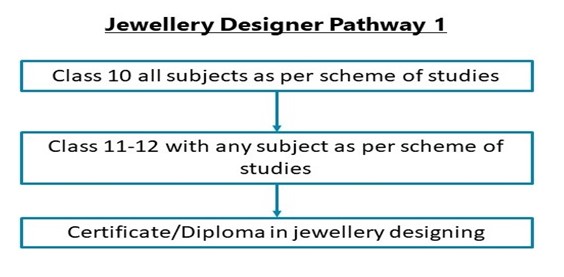
After completing Class 10 all subjects as per scheme of studies then complete Class 11-12 with any subject as per scheme of studies. If you have a keen interest in jewelry making and designing and have special creative skills then you can study even after your 12 classes for a short-term certificate course in jewelry designing from various schools such as NIFT (National Institute of Fashion Tech) or NID (National Institute of Design). However, it must be noted that in this field, creative skills and knowledge along with experience are taken into consideration rather than qualification.
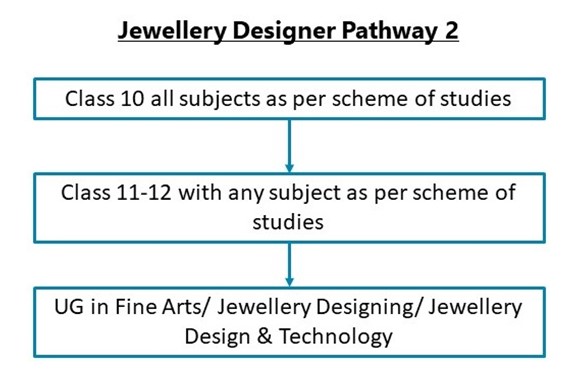
After completing Class 10 all subjects as per the scheme of studies then complete Class 11-12 with any subject as per the scheme of studies, and study for a Bachelor’s Degree in Fine Arts/ Jewellery Designing/ Jewellery Design & Technology from any arts or vocational college/university. However, it must be noted that in this field, creative skills and knowledge along with experience are taken into consideration rather than qualification.
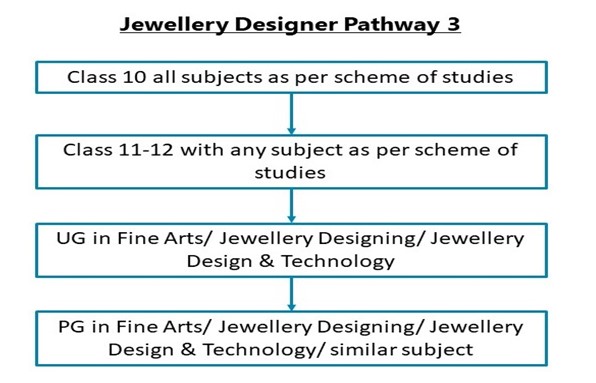
After completing Class 10 all subjects as per the scheme of studies then complete Class 11-12 with any subject as per the scheme of studies, and study for a Bachelor’s Degree in Fine Arts/ Jewellery Designing/ Jewellery Design & Technology g from any arts or vocational college/university and then study for Master’s Degree/ Post Graduate Diploma in Fine Arts/ Jewellery Designing/ Jewellery Design & Technology/ similar subject. However, it must be noted that in this field, creative skills and knowledge along with experience are taken into consideration rather than qualification.
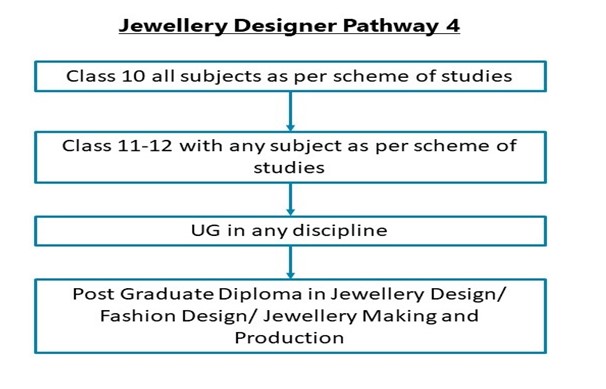
After completing Class 10 all subjects as per the scheme of studies then complete Class 11-12 with any subject as per the scheme of studies, and study for a Bachelor’s Degree in any discipline and then you can study for a postgraduate diploma course in Jewellery Design/ Fashion Design/ Jewellery Making and Production. However, it must be noted that in this field, creative skills and knowledge along with experience are taken into consideration rather than qualification.
Required Qualification & Competencies
You can do a Bachelor’s or Master’s degree in any one of the following fields to become a Jewellery Designer:
1. Fashion and Lifestyle Design
2. Jewellery Design
3. Lifestyle Accessories Design
MINIMUM EDUCATION REQUIRED | MAXIMUM EDUCATION REQUIRED |
Post Higher Secondary Diploma / Certificate Programs for which the minimum eligibility is a pass in Higher Secondary / Class XII School Leaving examination. | Post Graduate Postgraduate Degree / Diploma / Certificate Programs for which the minimum eligibility is a pass in Graduation / equivalent Diploma program like Honours Diploma or Graduate Diploma. |

Competencies Required
Interests
1. Artistic: You should have an interest in Artistic Occupations. Artistic occupations mostly involve working with creative ideas, art, and designs. These occupations involve abstract or conceptual thinking, and creative self-expression and often do not follow any set processes or rules for getting things done.
2. Enterprising: You should have an interest in Enterprising Occupations. Enterprising occupations involve taking initiative, initiating actions, and planning to achieve goals, often business goals. These involve gathering resources and leading people to get things done. These require decision-making, risk-taking, and action orientation.
3. Realistic: You should have an interest in Realistic Occupations. Realistic occupations involve more practical and hands-on activities than paperwork or office work. Realistic occupations often involve physical activities for getting things done using various tools and equipment.
Abilities
1. Abstract Reasoning: The ability to understand ideas that are not expressed in words or numbers; the ability to understand concepts that are not clearly expressed verbally or otherwise.
2. Deductive Reasoning: The ability to apply general rules and common logic to specific problems to produce answers that are logical and make sense. For example, understanding the reasons behind an event or a situation using general rules and common logic.
3. Fluency of Ideas: The ability to come up with several ideas about a topic (the number of ideas is important, not their quality, correctness, or creativity).
4. Inter-Personal: The ability to build and maintain good relationships with others at workplaces and elsewhere.
5. Originality: The ability to come up with unusual or innovative ideas about a given topic or situation, or to develop creative ways to solve a problem.
6. Selective Attention: The ability to concentrate on a task over a long period without being distracted.
7. Spatial Ability: The ability to visualize three-dimensional objects by looking at the objects on paper or visualize objects mentally in three dimensions.
8. Verbal Reasoning: The ability to think and reason with words; the ability to reason out ideas expressed in words.
9. Visualization: The ability to imagine how something will look after it is moved around or when its parts are moved or rearranged.
10. Written Comprehension: The ability to read and understand information and ideas presented in writing.
Knowledge
1. Creative Design: Knowledge of various techniques, methods, and specifications for creating and developing designs for various products and materials such as textiles, clothes, interiors, furniture, accessories, jewelry, animation, graphics, materials, film, video, web, user interfaces of digital devices, photography, etc.
Skills
1. Artistic and Visual Design: Skills in creating and developing designs which are visually appealing and attractive.
2. Critical Thinking: Skills in analysis of complex situations, using logic and reasoning to understand the situations and take appropriate actions or make interpretations and inferences.
3. Graphic Design Tools: Skills in using various graphic design tools such as Adobe Photoshop, Adobe Illustrator, Corel Draw, etc.
4. Judgment and Decision Making: Skills in considering the pros and cons of various decision alternatives; considering costs and benefits; and taking appropriate and suitable decisions.
5. Material Design and Craft: Skills in creating and designing various items using different materials such as clay, wood, iron, gold, silver, gems, etc.
6. Problem Solving: Skills in analysis and understanding of problems, evaluating various options to solve the problems, and using the best option to solve the problems.
7. Reading Comprehension: Skills in understanding written sentences and paragraphs in work-related documents.
Personality
1. You are always imaginative in most situations.
2. You always prefer to experience new things and have new experiences or you mostly do.
3. You can always act independently or could do so in most situations.
4. You are somewhat organized in your day-to-day life and activities.
5. You trust others sometimes but not always.
6. You are helpful to others sometimes.
7. You are mostly impulsive in your actions and behavior.
Career - Job Opportunities & Profiles
As a jewelry designer, you will get various opportunities at jewelry stores, repair shops, studios, workshops, retail stores, vocational schools and colleges, companies, designing outlets, boutiques, galleries, fashion design companies, etc.
1. At the entry-level, you can join for an internship working as a junior or assistant jewelry designer working under senior designers.
2. Many jewelry shops, repair shops, retailers, and manufacturers will hire you as a gemologist.
3. You will be hired as a jewelry appraiser in various appraisal firms, auction houses, insurance companies, etc.
4. Most of the schools and universities will hire you as an Arts and Crafts teacher.
5. You can get an opportunity as a graphic designer, CAD designer, product designer, fashion designer, or technical designer.
6. Many companies will hire you as a merchandiser.
7. You can start your own business in jewelry design.
8. Most universities and colleges will hire you as a professor at the position of junior professor or assistant professor.
Work environment
This is a very creative job where you will be expected to give a lot of effort and time and must have creative and technical skills along with market knowledge. Most of the time, as a designer, you will work full time in workshops or companies as a salaried designer; while the self-employed and freelance designers may set their schedules. As a freelance designer, you also have the luxury of working from home. However, you may also have to work on weekends and holidays to meet the consumer’s demand. This job also involves the risk of health and injury as some of you might have to handle the machines and tools. Sometimes, you will be required to travel to various fairs and exhibitions to trade your designs. Limited budgets and deadlines to complete the target make this job hectic.
Career Growth
1. As an intern, you will become a junior jewelry designer and then a senior jewelry designer. After gaining many years of experience, you will acquire managerial positions such as general manager, project manager, production manager, retail manager, etc., and then move to senior positions.
2. As a designer, such as a graphic designer, technical designer, CAD designer, etc., you will move to the senior positions.
3. career growth in university and college starts with the assistant professor and then associate professor, professor, and professor emeritus. Professors can also get administrative positions such as Director/Dean/Vice Chancellor, etc.
Salary Offered
1. As a trainee or intern or fresher, you can earn around Rs. 8,000 to 30,000 per month.
2. At the junior level with 2-6 years of experience, you can earn around Rs. 20,000 to 30,000 per month, if you are hired in a reputed firm you can expect to earn around Rs. 20,000 to 50,000 per month.
3. At mid-level with an experience of 6-12 years, you can around Rs. 50,000 to 80,000 per month, if you are at the higher post by this time you can expect to earn around Rs. 65,000 to 1,00,000 per month.
4. At the senior level, after gaining an experience of 15-20 years you will earn around Rs. 1,00,000 to 5,00,000 per month.
5. However, it must be noted that after becoming a famous designer you can earn a lucrative amount in this industry.
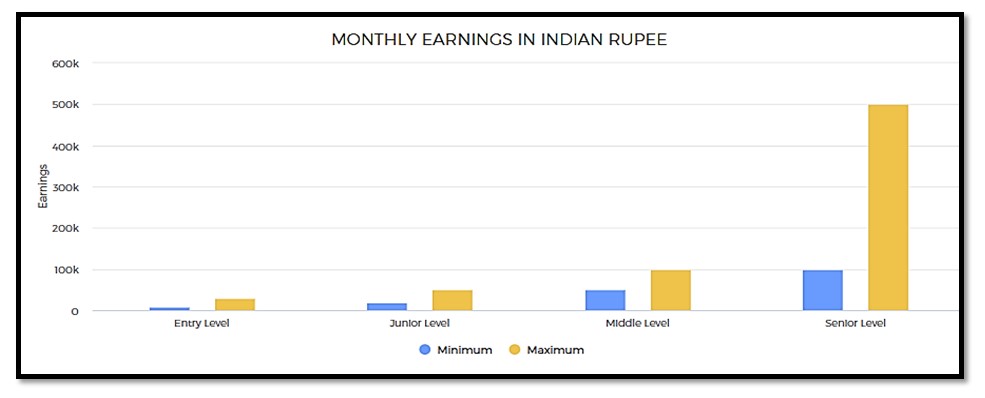
Monthly Earnings In Indian Rupee
Entry Level | Junior Level | Mid Level | Senior Level | ||||
Min Earning | Max Earning | Min Earning | Max Earning | Min Earning | Max Earning | Min Earning | Max Earning |
8000 | 30000 | 20000 | 50000 | 100000 | 150000 | 100000 | 500000 |
1. Entry level: 0 - 2 years of work experience
2. Junior Level: From 1 to 12 years of work experience
3. Mid Level: From 5 to 20+ years of work experience
4. Senior Level: From 10 to 25+ years of work experience (there could be exceptions in some high-end technical, financial, engineering, creative, management, sports, and other careers; also in the near future, people will reach these levels much faster in many careers and some careers, these levels will have no meaning as those careers will be completely tech skill driven such as even now, there is almost no level in a Cyber Security Expert’s job)
Work Activities
1. Communicating with co-workers and others: Communicating with people in writing, verbally or otherwise inside your workplace and various other people who have professional relationships with your place of work including vendors, government officials, etc., or with people at large.
2. Creative thinking: Developing new ideas, concepts, innovative solutions to problems, newer ways of getting things done, designing products and services, creating works of art and craft, etc.
3. Decision making and problem-solving: Analysis of data and information; evaluation of alternative decisions and results of decisions; taking the right decisions and solving problems.
4. Getting Information and learning: Observing, hearing, reading, using computers, or otherwise obtaining information and learning from it.
5. Organising, planning, and prioritizing tasks: Planning and organizing tasks to achieve work goals; prioritizing tasks to achieve goals and making the best use of the time available.
6. Providing advice and consultation to others: Giving advice or consultation to others about various issues, conceptual matters, know-how, scientific matters, products, or services.
7. Scheduling tasks: Scheduling project timelines, tasks and activities.
8. Updating and using relevant knowledge: Keeping updated with the latest knowledge relevant to your fields of work and using the relevant knowledge in getting things done.
9. Using computers for work: Using computers for day-to-day office work; using computer software for various applications in day-to-day professional work; entering data and processing information; for writing.
10. Working in a team: Working in a team of people; developing a team; and maintaining professional relationships among team members.
Future Prospects
The occupation of jewelry designing is expected to rise in the coming years. The fashion and design market is innovating day by day and creating many job opportunities for designers. The gold market is expected to rise as the domestic country consumes Gold more than other metals and it is the major source of investment. It will create more jobs across the country. But the ones who are self-employed may not get better opportunities as they would have to face the competition in the market and they will be highly affected by the demand and supply factors in the economy which may vary the number of jobs. Also, as many modern ornaments are coming into the market, it will reduce the demand for traditional ones.
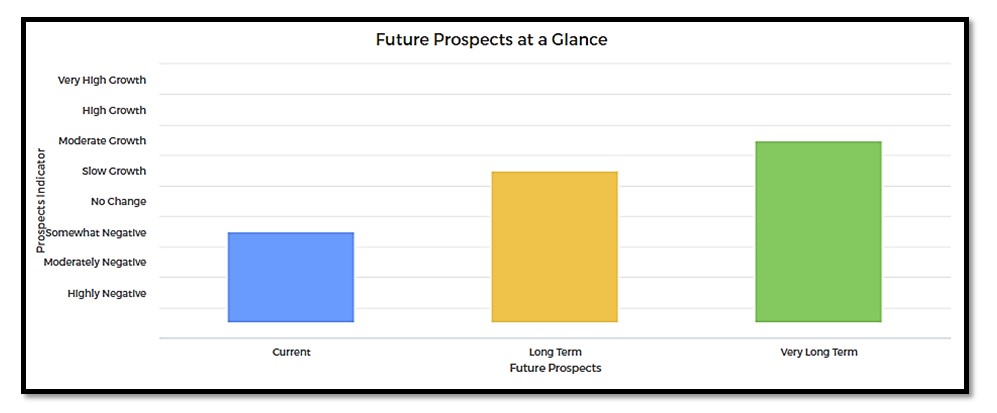
Future Prospects At A Glance
Current (0-1 year) | Long Term (2-5 years) | Very Long Term (6-10 years) |
Somewhat Negative | Slow Growth | Moderate Growth |


